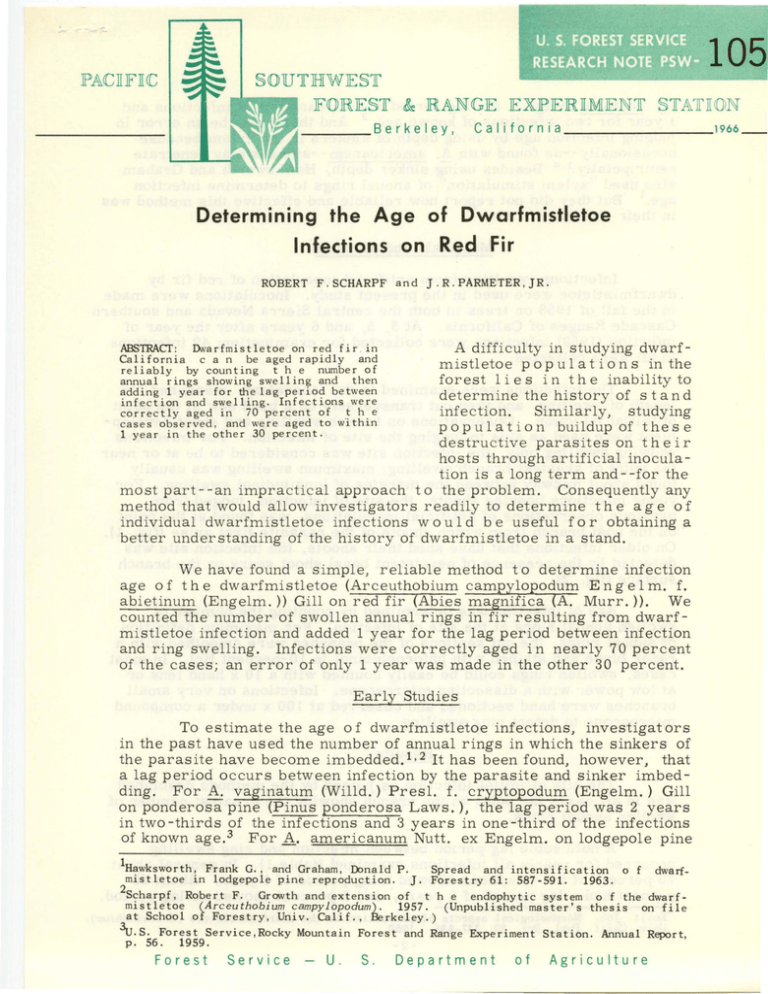105 ~ Determining the Age of Dwarfmistletoe
advertisement

105~ §OUTJHIW JE§T FORJE§T & RANGJE JEXJPJERlMJENT §TA1fTION JPACTIJfTI C _ _ _ _ B e r k e ley, C a I i for n i a 1966 _ _ Determining the Age of Dwarfmistletoe Infections on Red Fir ROBERT F.SCHARPF and J . R.PARMETER,JR. A difficulty in studying dwarfmistletoe populations in the forest lie sin the inability to determine the history of s tan d infection . Similarly, studying population buildup of these destructive parasites on the i r hosts through artificial inoculation is a long term and - -for the most part - -an impractical approach to the problem. Consequently any method that would allow investigators readily to determine the age 0 f individual dwarfmistletoe infections w 0 u 1 d be useful for obtaining a better understanding of the history of dwarfmistletoe in a stand. ABSTRACT : Dwarfmistletoe on red fir . in California c a n be aged rapidly and reliably by counting t h e number of annual rings showing swelling and then adding 1 year for ~e lag period between infection and swelling. Infections were correctly aged in 70 percent of t h e cases observed, and were aged to within 1 year in the other 30 percent. We have found a simple, reliable method to determine infection age 0 f the dwarfmistletoe (Ar ceuthobium camp ylopodum Eng elm. f. abietinum (Engelm.)) Gill on red fir (Abies magnifica (A. Murr. )). We counted the number of swollen annual rings in fir resulting from dwarfmistletoe infection and added 1 year for the lag period between infection and ring swelling. Infections were correctly aged in nearly 70 percent of the cases; an error of only 1 year was made in the other 30 percent. Early Studies To estimate the age 0 f dwarfmistletoe infections, investigat ors in the past have used the number of annual rings in which the sinkers of the parasite have become imbedded. 1 , 2 It has been found, however, that a lag period occurs between infection by the parasite and sinker imbedding. For A. vaginatum (Willd.) Presl. f. cryptopodum (Engelm.) Gill on ponderosa pine (Pinus ponderosa Laws.), the lag period was 2 years in two -thirds of the infections and 3 years in one -third of the infections of known age. 3 For A. americanum Nutt. ex Engelm. on lodgepole pine 1Hawksworth, Frank G., and Graham , Donald P . Spread and intensification mistletoe in lodgepole pine reproduction. J. Forestry 61: 587-591. 1963. 0 f dwan- 2Scharpf, Robert F. Growth and extension of t h e endophytic system 0 f the dwarfmistletoe (Arceuthobium campylopodum). 1957. (Unpublished master's thesis on file at School or Forestry, Univ. Calif., Berkeley.) 3u.s. Forest Service , Rocky Mountain Forest and Range Experiment Station. Annual Report , p. 56 . 1959. Forest Service - U. S. Department of Agriculture (P . contorta Dougl.), the lag period was 2 years for 12 infections and Cyear for two infections of known age. 2 And there may be an error in judging infection age by using depth of sinkers in the xylem because occasionally- -as found with A . americanum - -sinkers may penetrate centripetally .1, 4 Besides using sinker depth, Hawksworth and Graham also used "xylem stimulation" of annual rings to determine infection age .1 But they did not report how reliable and effective this method was in their studies. Materials and Methods Infections resulting from artificial inoculation of red fir by dwarfmistletoe were used in the present study. Inoculations were made in the fall of 1958 on trees in both the central Sierra Nevada and southern Cascade Ranges of California . At 3, 5, and 6 years after the year of infection (1959) infections were collected for examination; 42 infections in all were collected. The infections were examined in the laboratory, measured for length of swelling, and then cut transversely on a band saw at the point of initial infection. Observations on branch swelling and shoot development were used as aids in judging the site of infection . For infections showing swelling only, the infection site was considered to be at or near the point of greatest branch swelling; maximum swelling was usually found about midway between the margins of longitudinal swelling. For young infections bearing shoots, the site of infection, judged from previous observations of artificial inoculations, was found at the point on the host branch from which shoots of the parasite first arise (fig. 1). On older infec.tions..ihat haye..she.dJheir shoots., _th_e _infe.ciion-Bite -was detected by the presence of persistent basal shoot scars on the branch surface (fig. 2). Age of infection was determined by counting the number of swollen annual rings at the site of infection. For maximum definition of annual rings, the cut sections of the branches were smoothed with a razor blade and stained with phloroglucinol in 10 -percent Hcl. In most cases, swollen rings could be easily counted with a 10 x hand lens or at low power with a dissecting microscope. Infections on very small branches were -hancr-s-e-ciiDned -a::rrci--utrs-erved- ai 1 U-O-'x -u--rrder -a -compound microscope to detect ring swelling . Results The site of initial infection as judged by the methods described was in all cases the point on the branch showing the greatest number of swollen annual rings. A noticeable lag period between infection and ring swelling occurred for. nearly all infections examined (table 1). In general about 70 percent of the infections showed a lag period of 1 year. About 25 percent had a lag period of 2 years, and 5 percent showed no lag period. ~uijt , Job . Morphological aspects of parasitism in the dwarf mistletoes (Arceuthobium) . Univ . Calif. Pub!. Bot. 30 : 337 -436 . 1960 . -2 - Figure 1.--First crop of shoots of A. campylopodUm indicating the site of infection. Figure 2.--0Id basal shoot scars of A. campylopodum indicating the site of infection. -3- Figure 3.--Transverse section at infection site of red fir branch infected by dwarfmistletoe. Note pronounced initial ring swelling. I em Figure 4.--Transverse section at infection site of red fir branch infected by dwarfmistletoe. Not e slight initial ring swelling. I em -4 - Table 1 . - -Lag period between infection and annual ring swelling of red fir infected by dwarfmistl e toe Lag period (years) - - Area o 1_~ - 2 Numbe r of infections- Southern Cascades 2 11 2 Central Sierra Nevada o 18 9 Total 2 29 11 Initial ring swelling was usually quite pronounced (fig. 3), but in a few cases appeared as just a slight bump on the annual ring (fig. 4). Subsequent ring swelling typically extended bi -directionally around the stem and was usually quite pronounced (fig . 3, 4) . We found that considerably less swelling occurred in the new annual rings opposite the swollen portion of the previous year's annual rings (figs. 3,4). Apparently pronounced swelling is asso ci ated only with the advancing margin of the parasite's internal root-like system. Once the parasite extends completely around the branch, pronounced ring swelling at the infection site seemingly disappears . I Discussion Problems and questions may arise when using depth of sinkers in host xylem to determine age of dwarfmistletoe infections? , 6 Sinkers are for the most part microscopic structures , and the portion that becomes imbedded within the xylem may consist of only a uniseriate strand of cells. 7 Therefore, unless careful microscopic examination of the xylem tissue is made , the maximum depth of the sinkers may be misjudged . Sinkers may also penetrate centripetally, 6 7thus making it difficult to determine if they became imbedded in a given annual ring or penetrated into it . Persistence of sinkers in the xylem, particularly older ones, also has not been shown. Possibly, sinkers may deteriorate or become obliterated with age after they cease their function as nutrient-absorbing organs. The method of determining age of dwarfmistletoes described in this note has been used only with A . campylopodum on red f i r. It is possible, however, that further investigations will show that the method of judging age of infections by observing annual ring swelling will be equally effective with other species and forms of dwarfmistletoe on other hosts . 5Scharpf . Op . cit. ~awksworth and Graham . Op . ci t . 7Kuijt . Op . ci t. The Authors ____________________________________________________________ ROBERT F . SCHARPF is studying problems of forest diseases and their control , with headquarters ln Berkeley . A forestry graduate (1954) of the University of Missouri , he holds a master ' s degree in forestry (1957) and a doctorate in plant pathology (1963) from the University of California , Berke ley . J . R . PARMETER , JR . is an associate professor of plant pathology at the University of California , Berkeley . He earned a bachelor ' s degree in botany at Or egon State University (1951) and a doctorate in plant pathology at the University of Wisconsin (1955) . ~ 5- ·1






